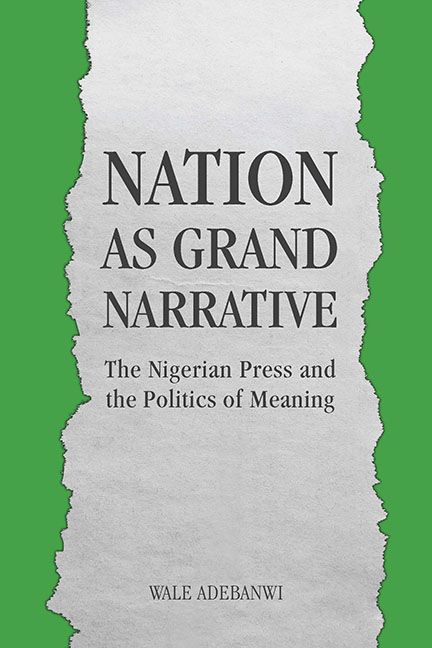Book contents
- Frontmatter
- Dedication
- Contents
- List of Illustrations
- Acknowledgments
- Part I Contextual and Conceptual Perspectives
- Part II Colonial Agency and Counterhegemonic Struggles
- Part III Inclusion, Exclusion, and Democratic Contestations
- 5 Paper Soldiers: Narratives of Nationhood and Federalism in Pre–Civil War Nigeria
- 6 Representing the Nation: Electoral Crisis and the Collapse of the Third Republic
- 7 The “Fought” Republic: The Press, Ethno-Religious Conflicts, and Democratic Ethos
- Part VI Domination and Resistance in Majority-Minority Relations
- Conclusion: Beyond Grand Narratives
- Notes
- Bibliography
- Index
6 - Representing the Nation: Electoral Crisis and the Collapse of the Third Republic
from Part III - Inclusion, Exclusion, and Democratic Contestations
Published online by Cambridge University Press: 16 February 2018
- Frontmatter
- Dedication
- Contents
- List of Illustrations
- Acknowledgments
- Part I Contextual and Conceptual Perspectives
- Part II Colonial Agency and Counterhegemonic Struggles
- Part III Inclusion, Exclusion, and Democratic Contestations
- 5 Paper Soldiers: Narratives of Nationhood and Federalism in Pre–Civil War Nigeria
- 6 Representing the Nation: Electoral Crisis and the Collapse of the Third Republic
- 7 The “Fought” Republic: The Press, Ethno-Religious Conflicts, and Democratic Ethos
- Part VI Domination and Resistance in Majority-Minority Relations
- Conclusion: Beyond Grand Narratives
- Notes
- Bibliography
- Index
Summary
What is Nigeria? A mere geographical expression or potentially a nation? And on what basis can the people who constitute it make claims on the polity? As members of different communities (ethnic or ethno-regional) or as individual rights-bearing citizens? Chapter 1 discussed the debate in Africa on whether the question of identity or that of democratic freedom should constitute the foundation for understanding belongingness within multicultural polities in Africa. This debate is mirrored in the questions above. Whereas scholars like Brendan Boyce argue that reconciling the issue of “identity redefinition” in the context of the historical limitations and opportunities in Africa is the way to go, Ivor Chipkin insists that this would lead to substituting the goal of a democratic society for that of an identity-based nation. He argues, on the contrary, that “the substance of a nation must be located in the determinate history of [the] ‘struggle for democracy’ in which it was elaborated.” Chipkin assumes that “democratic practice will allow for a constant process of fashioning and re-fashioning the nation.” n As James Sweet points out in his critique of Chipkin's position, the reality in multicultural Africa is different. “Unfortunately,” Sweet notes correctly, “potential citizens do not arrive at the democratic table as social ciphers. They always bring with them racial, ethnic, religious, and class identity.” This reality often presents challenges to the media, particularly in terms of how to reconcile democracy with nation-building, as Cliff Barnett shows.
As argued in chapter 1, the essentialization of democracy and freedom implicit in Chipkin's position is inflected differently in most African countries. This chapter provides empirical evidence for this position, as most of the newspapers and newsmagazines arrived at the democratic table seeking freedom as champions of ethnic, ethno-regional, and religious interests.
This chapter examines the narratives of the crisis of democratization in the Nigerian press in the 1990s in the context of antagonistic and competing identities within the Nigerian national space and the dangers that the subversion of democratic freedom constituted to the hopes of those who assumed that Nigeria's June 12, 1993, presidential election offered the country its greatest opportunity since the end of the civil war to begin the process of becoming a nationstate.
- Type
- Chapter
- Information
- Nation as Grand NarrativeThe Nigerian Press and the Politics of Meaning, pp. 146 - 189Publisher: Boydell & BrewerPrint publication year: 2016

